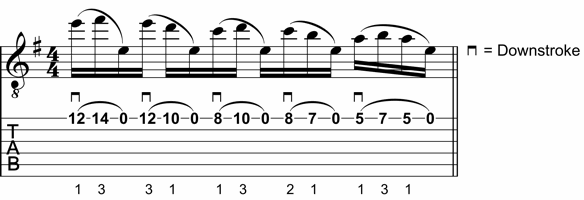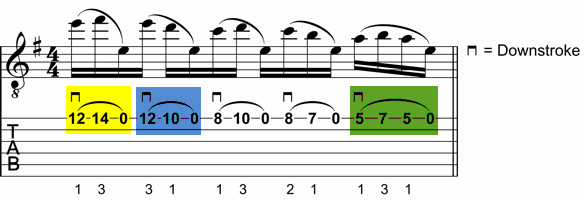I can’t believe we’re up to lick number eleven already! I hope you’ve been having fun with the ones that we covered earlier. 🙂
In this guitar lesson we’re going to look at a guitar lick that makes extensive use of the open thin E-string. It reminds me of the type of open string licks that both John Petrucci and Joe Satriani play.
Let’s get things kick-started by looking at the TAB of the lick…
Rock Guitar Lick 11: Open String Lick

If you’ve been diligently learning the previous licks, then you can probably see that this lick uses the E Natural Minor scale. While the scale might be the same as some of the earlier licks, the technical approach that we’re using to play the lick is very different. So let’s now go into more detail about how to technically execute the lick.
This lick is made up of three different legato patterns, which can be broken down like this…
Pattern One:
This legato pattern involves doing the following three things…
- Pick the first note using a downstroke.
- Hammer-on to a higher sounding note.
- Pull-off to the open string.
Pattern Two:
This is another three note legato pattern, and is played by doing this…
- Pick the first note using a downstroke.
- Pull-off to a lower sounding note.
- Pull-off to the open string.
Pattern Three:
This is a four note legato pattern. To play it you’ll need to do the following…
- Pick the first note using a downstroke.
- Hammer-on to a higher sounding note.
- Pull-off to the first note of the pattern.
- Pull-off to the open string.
Here’s the same lick with one example of each pattern being highlighted…

It would be a great idea to play each chunk of the lick now, and then compare it to the descriptions I wrote for each of the legato patterns. This will help you to understand the lick, rather than just mindlessly learning it. By understanding the lick fully, you’ll be in a better position to create your own variations. And creating variations of the licks you learn is a great idea, because it helps you to develop your own style of playing.
Hope you have fun with this lick!
Return To: Rock Guitar Licks